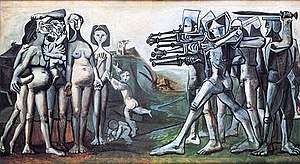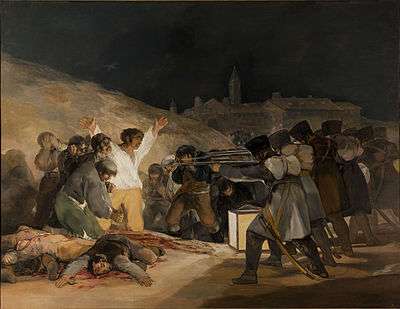Massacre in Korea
Massacre in Korea is an expressionistic painting completed on January 18, 1951, by Pablo Picasso; it condemns American intervention in the Korean War.[1][2][3] The painting is exhibited in the Musée Picasso in Paris.
| Massacre in Korea | |
|---|---|
 | |
| Artist | Pablo Picasso |
| Year | 1951 |
| Medium | Oil on plywood |
| Dimensions | 110 cm × 210 cm (43.3 in × 82.7 in) |
| Location | Musée Picasso, Paris |
It may depict an event similar to the No Gun Ri Massacre in July 1950, when an undetermined number of South Korean refugees were massacred by U.S. soldiers, or the Sinchon Massacre of the same year, an alleged mass killing carried out in the county of Sinchon, South Hwanghae Province, North Korea. Massacre in Korea depicts civilians being killed by anti-communist forces. The art critic Kirsten Hoving Keen says that it is "inspired by reports of American atrocities" in Korea.[4] At 43 inches (1.1 m) by 82 inches (2.1 m), the work is smaller than his Guernica. However, it bears a conceptual resemblance to that painting as well as an expressive vehemence.[5]
Picasso's work is influenced by Francisco Goya's painting The Third of May 1808, which shows Napoleon's soldiers executing Spanish civilians under the orders of Joachim Murat.[4] It stands in the same iconographic tradition of an earlier work modeled after Goya: Édouard Manet's series of five paintings depicting the execution of Emperor Maximilian, completed between 1867 and 1869.

As with Goya's The Third of May 1808, Picasso's painting is marked by a bifurcated composition, divided into two distinct parts. To the left, a group of naked women and children are seen situated at the foot of a mass grave. A number of heavily armed "knights" stand to the right, also naked, but equipped with "gigantic limbs and hard muscles similar to those of prehistoric giants." The firing squad is rigidly poised as in Goya. In Picasso's representation, however, the group is manifestly helter-skelter – as was often apparent in his portrayals of armored soldiers in drawings and lithographs – which may be taken to indicate an attitude of mockery of the idiocy of war. Their helmets are misshapen, and their weaponry is a mishmash amalgamation of the instruments of aggression from the medieval period to the modern era; not quite guns nor lances, they perhaps most resemble candlesticks. What is more, none of the soldiers have penises. This representational feature is highlighted by the pregnant state of the women on the left side of the panel. Many viewers have interpreted that the soldiers, in their capacity as destroyers of life, have substituted guns for their penises, thereby castrating themselves and depriving the world of the next generation of human life. Along with Guernica and The Charnel House (1944–45), this is one of Picasso's works that he composed to depict the politics of his time.[6]
Mentions in popular culture The painting is visualised in a slightly adapted version in the episode The Lawless of season 5 of the animation series Star Wars: The Clone Wars. There it appears as a wall mural in the closing scenes of the episode. The adaptations consist mainly of minor modifications so as to include Mandolorian soldiers as perpetrators and some of the massacred Jedi are given poses taken from Picasso's Guernica.
See also
References
- David Hopkins, After Modern Art: 1945–2000 (Oxford University Press, 2000), p.15. ISBN 0-19-284234-X, ISBN 978-0-19-284234-3
- Picasso A Retrospective, Museum of Modern Art, edited by William Rubin, copyright MoMA 1980, p.383
- Ingo F. Walther, Pablo Picasso, 1881–1973: Genius of the Century (Taschen, 2000), p. 94. ISBN 3-8228-5970-2, ISBN 978-3-8228-5970-4
- Keen, Kirsten Hoving. "Picasso's Communist Interlude: The Murals of War and Peace". The Burlington Magazine, Vol. 122, No. 928, Special Issue Devoted to Twentieth Century Art, July, 1980. p. 464.
- Boeck & Sabartés, p. 302.
- Nicholas John Cull, David Holbrook Culbert, David Welch, Propaganda and mass persuasion: a historical encyclopedia, 1500 to the present (ABC–CLIO, 2003), p.156. ISBN 1-57607-820-5, ISBN 978-1-57607-820-4
